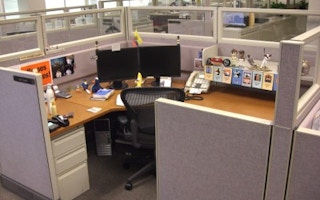Evidence is growing that ”green buildings” can improve staff productivity, driven by improvements in indoor air quality, lighting, thermal comfort, access to views and acoustics, according to Jones Lang LaSalle.
Jones Lang LaSalle’s director of sustainability, Joel Quintal, said assessing the drivers of office productivity was a complex topic. The quality of the physical environment - the issue at stake with ”green buildings” - was just one factor affecting productivity, he said.
The others included personal motivation and work satisfaction; organisational factors, such as the quality of management and pay rates; social factors - the relationship with office colleagues, or individual recognition within a business; and the role of technology such as IT and communication equipment.
An Ernst & Young report this week found that management issues (54 per cent), organisational structure (23 per cent), a lack of innovation (15 per cent) and outdated technology (8 per cent) were cited by employees as drains on productivity.
However, Mr Quintal told Business Day that high rates of natural ventilation and access to natural light were green building features that had a clear and undeniable link to increasing work productivity.
A 2005-06 case study of the retrofit of 500 Collins Street showed a 44 per cent reduction in the monthly average cost of sick leave. The study was done by Sustainability Victoria and the Kador Group.
Other findings were:
- A 9 per cent improvement in the average typing speed of secretaries and a big improvement in overall accuracy.
- One study found a 7 per cent reduction in headaches but another found a 20 per cent reduction. These studies also showed varying improvements in colds and flu, sore eyes, fatigue and poor concentration.
- In one study, there was no change in productivity, but a different study found a 12 per cent rise in self-reported productivity.
Mr Quintal said 2003 research into Californian call centre and desk office work spaces concluded that performance was boosted by better access to outside views and increased daylight intensity, provided there was no glare from the window.
A March 2010 British study of 10,000 property and construction professionals highlighted the issues. Fifty-five per cent were unhappy with the office temperature, more than 38 per cent rated noise levels too high, 33 per cent were unhappy with the amount of daylight, more than 40 per cent did not have a satisfactory outside view, and 45 per cent were unhappy with the ventilation or air quality.
Mr Quintal said sustainability in building design was becoming a key element of decision-making for companies. ”The office workplace is becoming a strategic tool that needs to be linked not only to the operational bottom line, but also to every company’s human resource strategy.”
Further, green buildings were good for property owners and landlords.
Mr Quintal said a 2003 US study of 33 green buildings found a building’s value improved by $37-$55 per square foot due to productivity gains.
”The results suggested some of these gains can be attributed to superior ventilation, lighting and general indoor environment,” he said.
A study by Jones Lang LaSalle and CoreNet Global found 48 per cent of corporate real estate executives would pay up to 10 per cent more rent to occupy a sustainable building, he said.








